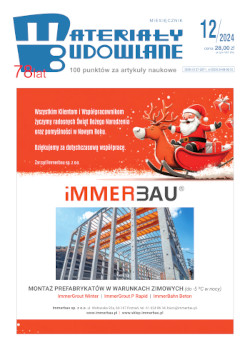dr inż. Małgorzata Fedorczak-Cisak, Politechnika Krakowska; Wydział Inżynierii Lądowej
dr hab. inż. Agnieszka Leśniak, prof. PK, , Politechnika Krakowska; Wydział Inżynierii Lądowej
dr hab. inż. arch. Przemysław Markiewicz-Zahorski, prof. PK, , Politechnika Krakowska; Wydział Inżynierii Lądowej
dr inż. Arkadiusz Węglarz, Politechnika Warszawska; Wydział Inżynierii Lądowej
dr inż. Paweł Jastrzębski, Akademia Górniczo-Hutnicza; Wydział Zarządzania
Adres do korespondencji: Ten adres pocztowy jest chroniony przed spamowaniem. Aby go zobaczyć, konieczne jest włączenie w przeglądarce obsługi JavaScript.
Upowszechnienie budownictwa niskoemisyjnego jest jednym z najbardziej pożądanych i skutecznych rozwiązań i bezwzględnie musi zdominować współczesny rynek budowlany. W artykule przedstawiono opracowaną metodykę oraz wyniki obliczenia śladu węglowego w przypadku dziewięciu wariantów technologicznych modelowego wielorodzinnego budynku mieszkalnego. W przypadku każdego wariantu wykonano szczegółowy kosztorys materiałów budowlanych i pracy sprzętu budowlanego. Wyniki analizy pozwoliły na wybór optymalnego pod kątem emisyjności wariantu techniczno-materiałowego budowy ścian budynku wielorodzinnego w standardzie nZEB.
Literatura
[1] Cabeza L. F., A. Castell, M. Medrano, I. Martorell, G.Pérez, I.Fernández.2010. „ExperimentalStudy on the Performance of InsulationMaterials inMediterraneanConstruction”. EnergyBuild. 42: 630 – 636.
[2] Chau C. K., T. M. Leung, W. Y. Ng. 2015. „A Review on Life Cycle Assessment, Life Cycle Energy Assessment and Life Cycle Carbon Emissions Assessment on Buildings”. Applied Energy 143 (1): 395 – 413. https://doi. org/10.1016/J. APENERGY. 2015.01.023.
[3] DongY. H., S. T. Ng. 2015. „ALife CycleAssessment Model for Evaluating the Environmental Impacts of Building Construction in Hong Kong”. Build Environ 89: 183 – 191.
[4] GuggemosAngelaAcree,ArpadHorvath. 2005. „Comparison of Environmental Effects of Steeland Concrete-Framed Buildings”. Journal of Infrastructure Systems 11 (2): 93 – 101. https://doi.org/10.1061/(ASCE)1076-0342 11: 2 (93).
[5] Hildebrandt Jakob, Nina Hagemann, Daniela Thrän. 2017. „The Contribution of Wood-Based Construction Materials for Leveraging a Low Carbon Building Sector in Europe”. Sustainable Cities and Society 34 (October): 405 – 18. https://doi.org/10.1016/j.scs.2017.06.013.
[6] „Independent Building Test, Research, Instruments and Information – BSRIA”. 2022.2022.
[7] Junnila Seppo, Arpad Horvath, Angela Acree Guggemos. 2006. „Life-Cycle Assessment of Office Buildings in Europe and the United States”. Journal of Infrastructure Systems 12 (1): 10 – 17. https://doi.org/10.1061/(ASCE)1076-0342 12: 1 (10).
[8] Lieto Vollaro Roberto De, Claudia Guattari, Luca Evangelisti, Gabriele Battista, Emiliano Carnielo, Paola Gori. 2015. „Building Energy Performance Analysis: A Case Study”. Energy and Buildings 87 (January): 87 – 94. https://doi. org/10.1016/J.ENBUILD. 2014.10.080.
[9] Llantoy N., M. a Chàfer, L. F. Cabeza. 2020. „AComparative Life CycleAssessment (LCA) of Different Insulation Materials for Buildings in the Continental Mediterranean Climate”. Energy and Buildings 225, Volume 225.
[10] Madhumathi A., M. C. Sundarraja, R. Shanthipriya. 2014. „A Comparative Study of the Thermal Comfort of Different Building Materials in Madurai”. Int J Earth Sci Eng, 7 (3): 1004 – 1018.
[11] Marszal A. J., P. Heiselberg, J. S. Bourrelle, E. Musall, K. Voss, I. Sartori, A. Napolitano. 2011. „Zero Energy Building – A Review of Definitions and Calculation Methodologies”. Energy and Buildings 43 (4): 971 – 79. https://doi. org/10.1016/J.ENBUILD. 2010.12.022.
[12] Pisello A. L., V. L. Castaldo, G. Pignatta, F. Cotana, M. Santamouris. 2016. „Experimental In-Lab and in-FieldAnalysis ofWaterproofMembranes for Cool RoofApplication and Urban Heat Island Mitigation”. Energy and Buildings 114 (February): 180–90. https://doi.org/10.1016/j.enbuild. 2015.05.026.
[13] Schiavoni S., F. D’Alessandro, F. Bianchi, F. Asdrubali. 2016. „Insulation Materials for the Building Sector: A Review and Comparative Analysis”. Renew. Sustain. Energy Rev., 62: 988 – 1011.
[14] VillasmilWilly, Ludger J. Fischer, JörgWorlitschek. 2019. „A Review and Evaluation of Thermal Insulation Materials and Methods for Thermal Energy Storage Systems”. Renewable and Sustainable Energy Reviews. Elsevier Ltd. https://doi.org/10.1016/j.rser.2018.12.040.
Materiały Budowlane 01/2022, strona 46-49 (spis treści >>)





























